
For the past year and a half I’ve been trying to generate a healthy dose of steam in my extremely well vented gas oven. Steam that would be present in good volume for at least the first 15 minutes. My experimentation had mixed results. The bread tastes great, but I want the appearance be as good as the taste.
I’ve tried water in a preheated pan, ice cubes in a preheated pan, a cup of water over preheated lava rocks in a pan, spraying the bread, covering the bread, plus the great tips offered by Giovanni and SylviaH using hot wet towels. While these techniques sure did humidify my house, open cuts and a nice grigne just didn’t materialize.
One method that did work with some success was SteveB’s. Alas, my thrift-store aluminum roaster cover is a tad wider than my stone, so I don’t have a good seal between the lid and the stone.
David Snyder had written about the steaming technique recommended for home bakers by SFBI
It looked interesting, but I didn’t want to buy yet another gizmo. So I made my own version by poking holes through a foil loaf pan (three for a buck at the local dollar store) and setting it on top a layer of lava rocks in the bottom of a metal loaf pan. The holes were large in the first version.
I experimented with both steaming versions over Thanksgiving weekend using Hamelman’s sourdough formula. 
The loaf in the background was baked covered, using SteveB’s technique. Oven and stone preheated to 500F, loaf loaded and covered (the cover was not preheated). Two shots of steam were directed through the hole in the cover, plus one cup of water was poured into a wide broiler pan containing lava stones (done because of the cover overlap). I forgot to turn down the heat until I removed the cover, 15 minutes later. Bake finished at 460F.
The loaf in the foreground was baked uncovered. After loading the bread into the preheated 500F oven (and stone), one tray of ice cubes was placed in the foil tray resting over the lava rocks on the left side of the oven and about 1.5 cups of water poured into the broiler pan containing lava rocks on the right side of the oven. Temp reduced to 460F. After 15 minutes the broiler pan was dry and emitted no steam so it was left in the oven. The foil-trayed loaf pan was removed. Although I screwed up the scoring on the bread in the foreground, the results looked promising.
I didn’t think the sufficient steam had been generated, so I made much smaller holes in another foil pan and replaced the original version.

I mixed the same dough the following weekend. Oven and stone again preheated to 500F. A batard was scored and loaded. This time TWO trays of ice cubes were dumped into the foil tray and 2.5 cups of water poured into the broiler pan w/lava rocks. About 16 minutes later I removed the loaf pan; I could see the steam still coming off the lava rocks. I left the broiler pan in, as that water had evaporated. Here’s the result.

To make sure this was no fluke, I followed the same procedure with the second batard. It worked again!

I am overjoyed to finally have figured out how to generate an abundance of steam in my oven for those crucial first minutes.

Finally, my bread looks as great as it tastes! Thank you SteveB, David, and all the other fine bakers who have been so inspiring.















